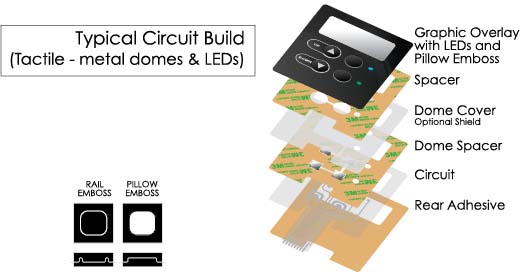Innovative Membrane Switch Solutions for Customized Control Panels
Innovative Membrane Switch Solutions for Customized Control Panels
Blog Article
Understanding Membrane Layer Switches: The Secret to Durable and Trustworthy Controls

What Are Membrane Buttons?
Membrane layer buttons are an innovative solution in the realm of user interface technology, combining performance and style effortlessly. These tools work as a user interface in between customers and digital systems, incorporating numerous parts right into a portable layout. Typically constructed from flexible, slim layers of products, membrane layer buttons are created to react to touch, making it possible for individuals to engage with equipment and electronic devices efficiently.
The main components of a membrane button include a published circuit layer, graphic overlay, and a spacer layer that protects against unintentional activation. The graphic overlay can be customized to reflect brand name identification or individual preferences, improving looks while making certain usability. Membrane switches are commonly made use of in numerous applications, including medical tools, customer electronics, and commercial tools, owing to their toughness and resistance to environmental elements such as dampness and dirt.
One of the vital benefits of membrane buttons is their capability to endure damage, making them suitable for high-traffic atmospheres. Additionally, they are light-weight and need very little space, enabling ingenious designs in item development. On the whole, membrane switches over represent a practical and effective choice for modern-day electronic user interfaces, marrying innovation with user-centric design principles.
Just How Membrane Switches Over Work
The procedure of membrane layer switches over hinges on an easy yet reliable device that translates individual input right into digital signals. When an individual presses the switch, the leading layer warps, permitting a conductive component in the circuit layer to make contact with a corresponding conductive pad on the underside of the visuals overlay.
The style of membrane layer buttons can differ, but they typically integrate domes or responsive components to give feedback to the user, enhancing the overall experience - membrane switch. The materials made use of in membrane layer buttons, such as polyester or polycarbonate, add to their resilience and resistance to environmental aspects, consisting of wetness and dust. The published circuits are usually encapsulated, which safeguards them from wear and tear over time.
Benefits of Membrane Switches

Furthermore, membrane switches are understood for their toughness. Created from durable products, they are immune to dirt, dampness, and physical wear, which dramatically expands their Continued life-span contrasted to traditional mechanical buttons. This durability makes them particularly suitable for high-traffic settings and applications calling for long life.
An additional substantial advantage is the convenience of cleansing and maintenance. The smooth surface of membrane switches reduces dirt accumulation and is typically invulnerable to spills, making them suitable for setups that need frequent sanitization.
Moreover, membrane layer buttons use a streamlined profile, leading to a thinner layout that can be incorporated into various tools without including bulk. This feature not just improves the aesthetic appeal yet likewise contributes to an extra ergonomic item design.
Applications of Membrane Layer Buttons
Straightforward and flexible, membrane buttons discover applications throughout a large range of industries, consisting of medical tools, consumer electronics, and commercial equipment. In the clinical field, these buttons are essential to devices such as diagnostic tools, client tracking systems, and mixture pumps, where dependability and ease of cleansing are vital. Their capacity to stand up to harsh settings and maintain performance makes them ideal for such applications.

In customer electronics, membrane buttons are made use of in products like microwaves, washing makers, and remote controls - membrane switch. Their smooth layout permits intuitive individual interfaces, boosting the overall individual experience while giving resilience and resistance to tear and put on
Commercial equipment likewise takes advantage of membrane layer buttons, specifically in control panels for machinery and automation systems. These buttons supply protection against dust and wetness, making certain regular performance in challenging environments. Moreover, their adjustable attributes allow suppliers to customize them to details functional demands, enhancing effectiveness and performance.
Picking the Right Membrane Layer Switch Over
When choosing a membrane switch, it is vital to take into consideration numerous aspects that influence efficiency and viability for certain applications. The main considerations include ecological problems, tactile feedback, resilience, and design requirements.
First, examine the operating atmosphere; switches revealed to dampness, chemicals, or extreme temperatures call for certain materials to ensure long life and performance. Next, review the requirement for tactile feedback. Depending upon user communication, some applications may take advantage of a responsive reaction to validate activation, while others may prefer a non-tactile layout for aesthetic factors.
Toughness is one more critical aspect; membrane buttons ought to be made to stand up to frequent usage, impacts, and abrasion. Make certain the selected button can endure the anticipated lifecycle, specifically in high-usage situations.

Final Thought
In final thought, membrane layer switches over offer as important components in the design of reputable and long lasting control systems throughout numerous industries. The versatility of membrane changes enables for tailored solutions that meet details operational demands, reinforcing their significance in contemporary innovation.
Membrane layer changes stand for i loved this a crucial aspect of contemporary interface style, blending functionality with strength in different applications.Membrane layer switches are an advanced service in the realm of user interface technology, combining capability and layout effortlessly. Normally created from flexible, slim layers of materials, membrane switches are developed to respond to touch, enabling individuals to engage with machinery and electronic devices efficiently.
The design of membrane layer buttons can differ, yet they usually incorporate domes or responsive components to provide comments to the user, improving the total experience.In verdict, membrane changes offer as important parts in the style of long lasting and dependable control systems across numerous sectors.
Report this page